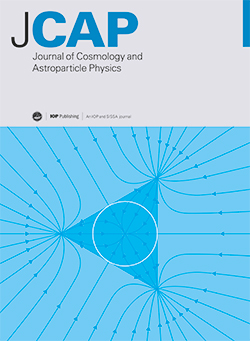Induced gravitational wave interpretation of PTA data: a complete study for general equation of state
IF 5.3
2区 物理与天体物理
Q1 ASTRONOMY & ASTROPHYSICS
Journal of Cosmology and Astroparticle Physics
Pub Date : 2024-08-28
DOI:10.1088/1475-7516/2024/08/054
引用次数: 0
Abstract
We thoroughly study the induced gravitational wave interpretation of the possible gravitational wave background reported by PTA collaborations, considering the unknown equation of state w of the early universe. We perform a Bayesian analysis of the NANOGrav data using the publicly available PTArcade code together with SIGWfast for the numerical integration of the induced gravitational wave spectrum. We focus on two cases: a monochromatic and a log-normal primordial spectrum of fluctuations. For the log-normal spectrum, we show that, while the results are not very sensitive to w when the GW peak is close to the PTA window, radiation domination is out of the 2σ contours when only the infra-red power-law tail contributes. For the monochromatic spectrum, the 2σ bounds yield 0.1 ≲ w ≲ 0.9 so that radiation domination is close to the central value. We also investigate the primordial black hole (PBH) abundance for both monochromatic and log-normal power spectrum. We show that, in general terms, a larger width and stiffer equation of state alleviates the overproduction of PBHs. No PBH overproduction requires w ≲ 0.57 up to 2-σ level for the monochromatic spectrum. Furthermore, including bounds from the cosmic microwave background, we find in general that the mass range of the PBH counterpart is bounded by 10-5M⊙ ≲ MPBH ≲ 10-1M⊙. Lastly, we find that the PTA signal can explain the microlensing events reported by OGLE for w ~ 0.7. Our work showcases a complete treatment of induced gravitational waves and primordial black holes for general w for future data analysis.PTA 数据的引力波解释:一般状态方程的完整研究
考虑到早期宇宙的未知状态方程 w,我们深入研究了 PTA 合作组织报告的可能引力波背景的诱导引力波解释。我们使用公开的 PTArcade 代码和 SIGWfast 对 NANOGrav 数据进行了贝叶斯分析,以对诱导引力波频谱进行数值积分。我们重点研究了两种情况:单色波动和对数正态原始频谱。对于对数正态频谱,我们的研究表明,当引力波峰值接近 PTA 窗口时,结果对 w 并不十分敏感,但当只有红外幂律尾产生影响时,辐射支配会超出 2σ 等值线。对于单色光谱,2σ 等值线的结果是 0.1 ≲ w ≲ 0.9,因此辐射主导接近中心值。我们还研究了单色和对数正态功率谱的原始黑洞(PBH)丰度。我们发现,一般来说,较大的宽度和较硬的状态方程会减轻 PBH 的过量产生。对于单色谱而言,w ≲ 0.57(最高可达 2-σ 级)时,PBH 不会过量产生。此外,包括来自宇宙微波背景的约束在内,我们发现一般来说,PBH对应物的质量范围约束为10-5M⊙ ≲ MPBH ≲ 10-1M⊙。最后,我们发现 PTA 信号可以解释 OGLE 报告的 w ~ 0.7 的微透镜事件。我们的工作展示了对一般w条件下诱导引力波和原始黑洞的完整处理,可供未来数据分析之用。
本文章由计算机程序翻译,如有差异,请以英文原文为准。
求助全文
约1分钟内获得全文
求助全文
来源期刊

Journal of Cosmology and Astroparticle Physics
地学天文-天文与天体物理
CiteScore
10.20
自引率
23.40%
发文量
632
审稿时长
1 months
期刊介绍:
Journal of Cosmology and Astroparticle Physics (JCAP) encompasses theoretical, observational and experimental areas as well as computation and simulation. The journal covers the latest developments in the theory of all fundamental interactions and their cosmological implications (e.g. M-theory and cosmology, brane cosmology). JCAP''s coverage also includes topics such as formation, dynamics and clustering of galaxies, pre-galactic star formation, x-ray astronomy, radio astronomy, gravitational lensing, active galactic nuclei, intergalactic and interstellar matter.
文献相关原料
| 公司名称 | 产品信息 | 采购帮参考价格 |
|---|
 求助内容:
求助内容: 应助结果提醒方式:
应助结果提醒方式:


